
By Dennis D. Ottobre

As a military rifle collector there is no way for me to pick a "favorite" from my collection but I do find Yugoslavian M95M conversion rifles fascinating. Very little information has been published in English on these odd rifles although there is mention of them here and there with little or no detail. I had purchased my fist M95M (the lower rifle pictured) back in 1995 with a pile of M1895 Steyr carbines and noticed nothing until I discovered no M95 bayonet would fit on it due to the muzzle ring inside diameter on the bayonet being too small by 0.5mm. That's when I finally noticed the odd barrel length being longer than the other carbines but far shorter than a full sized rifle and decided to set it aside until I knew what it was. Fast forward almost 4 years to 1998 when I made the bayonet collecting part of my hobby into a full time on-line business. While test fitting a small group of M95 bayonets I had acquired for resale I came across one with a large MRID. The light bulb went on in my brain and I mated the rifle and bayonet perfectly. I still had no clue about the who, what or why until sometime in 2000 when I was thumbing through my copy of "The Book Of Rifles" and found a short blurb identifying this very rifle. Mystery solved BUT more mysteries were yet to come.

In 2005 I was at a gun show and tripped over the upper rifle shown. I knew it was an M95M by this time but the seller had no clue. He confirmed his lack of knowledge when he told me I would need the Mannlicher clip he gave me with it if I wanted to shoot it. Since these rifles are reworked M95 Steyrs reconfigured for use with 8x57mm ammunition in stripper clips I just kind of chuckled, paid the man a price that would have been good for a common Steyr M95 carbine and walked away with what I thought was an upgrade to my collection. When I got it home and did a side by side comparison of my 2 M95Ms I discovered that I now had 2 different variants. The upper rifle has a recycled and reconfigured M95 stock while the lower rifle has a completely newly Yugo made stock. Note the differences in the center barrel bands especially. So why have 2 variants and why recycle old stocks on some while going through the trouble of making new stocks for others in a different configuration? After multiple side by side comparisons with unaltered M95 Steyr long rifles and carbines it is clear that the variant using the cut down original M95 stock was definitely made from a full length rifle as opposed to a carbine. This would seem obvious but it is important to note that the original rifle barrel band differs from the different barrel bands found on different carbine variants. I speculate that those M95M rifles equipped with the newly made stock were probably built from original M95 carbines that originally had stocks that would be too short for use on the M95M reworks. I possess an unaltered M95 carbine made by Steyr in 1903 for a Bulgarian contract. My M95M with new made stock is also built on an action from the 1903 Bulgarian contract so I suspect it was also a carbine. This is certainly not conclusive but provides a basis for more study.
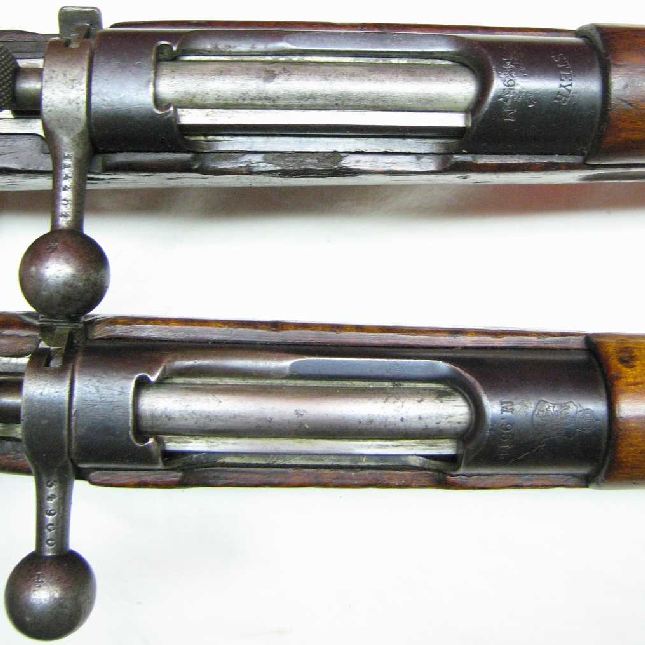
Note the stripper clip guide cuts in the receiver bridges and the "M" suffix added to the nomenclature on both examples. The upper rifle bore no prior property marks and the lower rifle was previously a Bulgarian issued example. These came to Yugoslavia from all over after WWI but were of little use to Yugoslavia after standardizing the use of the 8x57mm cartridge in 1924. The Steyr rifles were stored until finances and needs dictated the feasibility of converting them from their original 8x50R caliber and changing the Mannlicher loading and feeding system to the Mauser type "stripper clip" charging system . The conversions were done by the commercial firm Yakov Poshinger Arms and Ammunition Factory (FOMU) in Uzice, Yugoslavia under contract for the Yugoslav Government due to inadequate capacity to effect the conversions within the Military Technical Institute (AT3 and BT3) at Kragujevac, Yugoslavia. The contract for conversion was bid out in 1933 and FOMU was contracted to perform the conversion beginning in March 1938 completing the work by Mid 1939. The contract specified conversion of 10,000 rifles at a rate of 50 per day. The barrel used is actually the Yugoslavian M24 "Mauser" barrel supplied to FOMU by Kragujevac which was producing the M1924 rifle at the time.
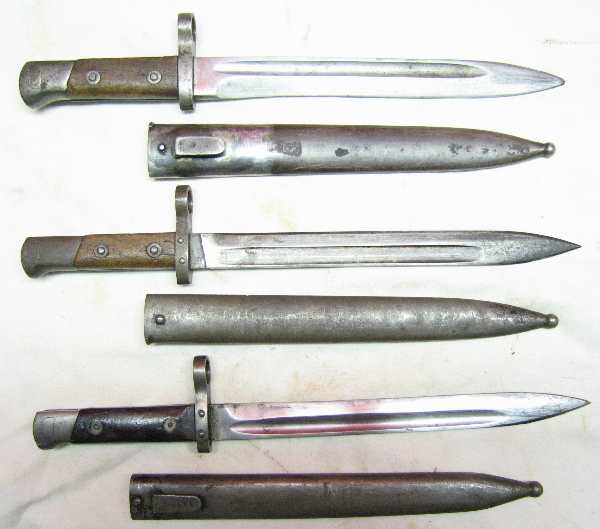
The bayonets are also poorly documented and usually misidentified when found. The original bayonet I had was just a common Austro-Hungarian M95 with its MRID reamed out a bit larger for the M24 type barrel to fit. The bottom bayonet in the pictures is such a bayonet but has also had it's grips replaced by Yugoslavia and fixed with their signature spanner head screws. The markings were not changed although they will sometime be found with the triangular Yugo AT3 mark on the ricasso. The scabbard is of new Yugo construction and is unique among M95 series scabbards.
The center bayonet shown is one made from the parts of former Austro-Hungarian
M1888/16 bayonets and are quickly identified by the long pommel and short
grips. At the time this article was written I had had 3 of these
and the one depicted was acquired from fellow BCNer Earl Stanford.
Until I purchased this one and mounted it to the M95M I had not confirmed
the identity of these as it never occurred to me to try mounting the ones
I owned previously. The discovery with the center bayonet opened
my mind up to more possibilities. At the same time I discovered the
identity of the center bayonet I had the top bayonet shown on hand with
no positive ID so I figured "why not give it a try". I was tickled
pink when it mounted on the M95M and like the center bayonet it is derived
from a design for the M1888 Steyr.
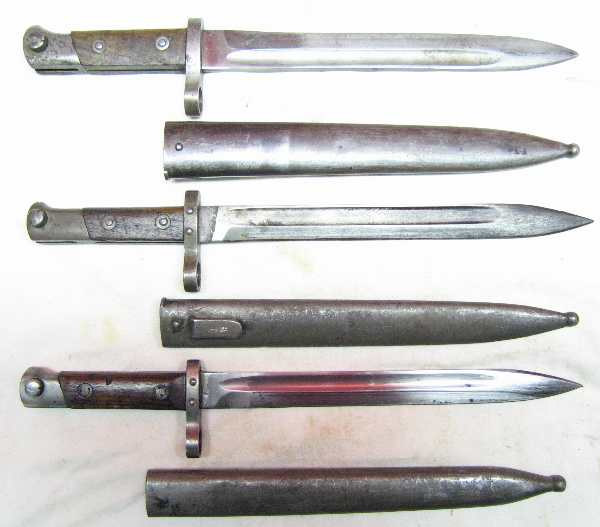
M95M conversion bayonets made from Austro-Hungarian M1890 bayonets.
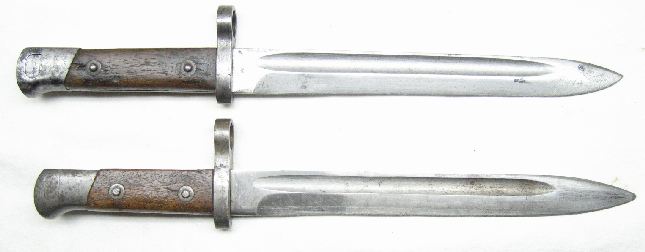
The top bayonet depicted above is usually identified as an Austro-Hungarian M1890 bayonet for the RG1888 series rifles. The lower bayonet is a Yugoslavian conversion of a leftover M1890 bayonet to fit the M95M rifle. The hilt was shortened and a new crossguard based on an M1895 bayonet crossguard blank with larger muzzle ring inside diameter for the M95M.
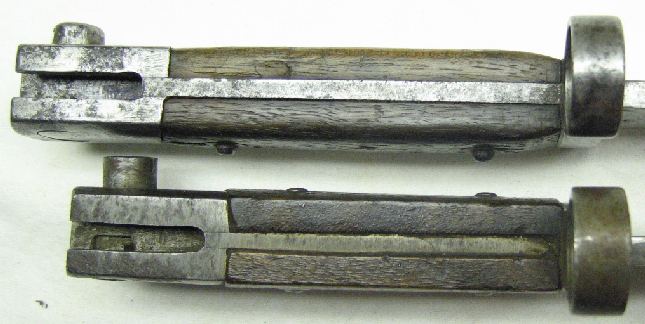
The pommel was removed from the tang, a new crossguard installed then the original pommel recycled and reinstalled on the shortened tang.
M95M conversion bayonets made from Austro-Hungarian M1888/16 bayonets.
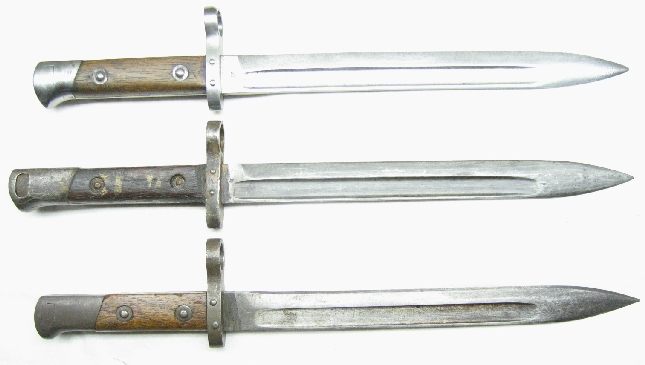
During WWI The Austro-Hungarian Empire fielded the M1895 Steyr as it's main battle rifle. Due to wartime shortages of arms many obsolete RG1888 series rifles were pressed back into service for second line and rear echelon troops. An additional shortage of bayonets resulted in several variations of bayonet being produced for these obsolete rifles as well as the first line M95 rifles. Given limited manufacturing capacity that could not keep up with wartime demands deriving multiple uses for parts already being produced maximizes manufacturing effectiveness to take better advantage of a nation's manufacturing capacity when limited.
The image above depicts the evolution of the M1895 bayonet to the M1888/16 to a final version of the M95M. The M1895 bayonet is depicted at the top in the image above. The second bayonet depicted above was one such variant for the RG1888 series rifles. It was constructed using modified M1895 components that were already being produced. The blade and tang are standard M1895 type. The crossguard is also from a blank M1895 crossguard but with a larger muzzle ring inside diameter and mounted lower on the blade to account for the lower muzzle ring height on the RG1888 series rifles. Note that the "quillon" end of the crossguard extends farther from the hilt than that on the M1895 bayonet above it. The pommel was of a unique new construction being made longer than what would seem normal at a glance. The extra pommel length is to compensate for the shorter than needed M1895 tang as the RG1888 series rifles require a longer lug to muzzle ring distance to mount their bayonets. The bottom bayonet is a later Yugoslavian conversion of a leftover M1888/16 bayonet to fit the M95M.

M1895 tang compared to the M1888/16 tang.
After WWI when Yugoslavia and Czechoslovakia were formed the new nations received and employed a great deal of former Austro-Hungarian arms until both nations moved quickly to variations on the German GEW98 series of rifles. The Czechs began as early as 1922 and Yugoslavia in cooperation with FN of Belgium in 1924. The Czechs also fielded a new design in 1924 leaving today's collector with the Belgian FN24, Czech VZ24 and Yugoslav M1924 being very close to the same rifle with the same nomenclature. Fast forward to 1938 when Yugoslavia began reworking of former M95 rifles to the M95M configuration by installing M24 barrels as discussed above. In addition to modifying the M1895 bayonet to fit many others bayonets were modified to include existing stocks of M1888/16 bayonets.

M1888/16 tang compared to the M95M tang.
The M1888/16 bayonets had their grips removed and tangs shortened then a new crossguard for the M95M was installed before the pommel was remounted to the shortened tang to create this version of the M95M bayonet. A similar operation was conducted by Portugal to convert their M1904 bayonet to fit the M1934 Steyr-Soluthurn sub machinegun. The Soluthurn converted bayonet incidentally fits the original M1895 Steyr as well since the SMG was built to accept the existing M95 bayonet.
Double edged variant of the Serbian M1899 bayonet was constructed for use on Serbian and captured Turkish "export pattern" Mauser rifles. (Bogdanovic also identifies this model as an M1899C depending on the era that it is used. It is also incorrectly referred to by some collectors as an "M1915". I am guilty of using this identification and would like to interject my personal thanks to Branko Bogdanovic for taking the time to personally explain the correct nomenclatures to me.) The term "export pattern" refers to the critical dimensions used to determine what bayonet fits. It is characterized by a 15.5mm MRID (the same as the M95M) and a set muzzle ring to locking catch distance (locking distance) and muzzle ring height. The M95M has a shorter locking distance and lower muzzle ring height. Bending back the upper portion of the crossguard and reshaping it to something resembling a letter "s" places the muzzle ring at just the right height and locking distance to make the bayonet fit the M95M.
Export pattern M1899 double edged bayonet.

COURTESY DORLIN KERR COLLECTION dkerr45394@roadrunner.com
M95M modified M1899 bayonet.
Components of the Yugoslav M1924 bayonet were also used in making bayonets for the M95M but it is unclear if these were produced from incomplete or blank bayonet components or if they are actually conversions of existing bayonets.

The Yugoslav M1924 bayonet.

COURTESY BRANKO BOGDANOVIC
The Yugoslav long M95M bayonet based on the M1924 bayonet.
This long M95M bayonet is based on the M1924 with M95M crossguard installed and hilt shortened. I have never observed a physical example of this bayonet but I strongly suspect it is a conversion of an existing M1924 bayonet as opposed to being newly purpose built.
COURTESY BRANKO BOGDANOVIC
Another variation of M95M conversion of the M1924 bayonet. This conversion uses what appears to be a shorter version of the M1924 pommel which compensates for the shorter locking distance of the M95M. This pommel has a T type mortise slot.

COURTESY RONNIE WILSON COLLECTION
This example has had the muzzle ring removed from the crossguard.
Such muzzle ring removal of Yugoslavian bayonets is generally characteristic
of WWII German adaptation practices for re-issued Yugoslav bayonets but
in this case with the shorter T slot pommel it would have been relegated
to the status of a knife or sidearm as it will no longer mount on any rifle.
The long pommel with it's long T/O mortise slot would be required to mount
any such bayonet lacking a muzzle ring.
References used in researching this article:
Branko Bogdanovic. Serbian And Yugoslav Mauser Rifles. North Cape Publications, Inc., Tustin, CA, USA 2005
W.H.B. and Joseph E. Smith. The Book Of Rifles. The Stackpole Co., Harriburg, PA, USA 1960 and 1963
My special thanks to the following people who contributed to this article:
Branko Bogdanovic
David Hughes
Dorlin Kerr dkerr45394@roadrunner.com
Nebojsa Milanovic
Ronnie Wilson